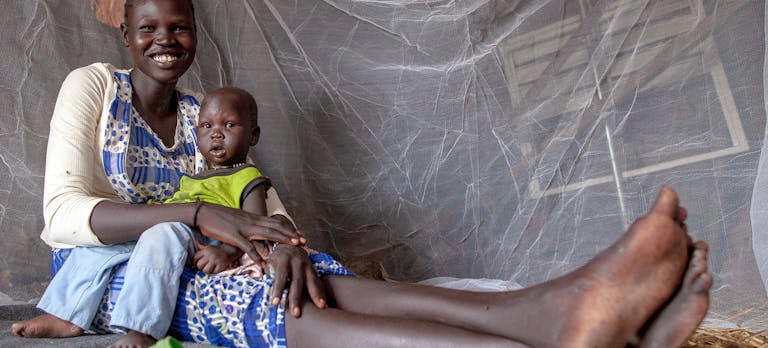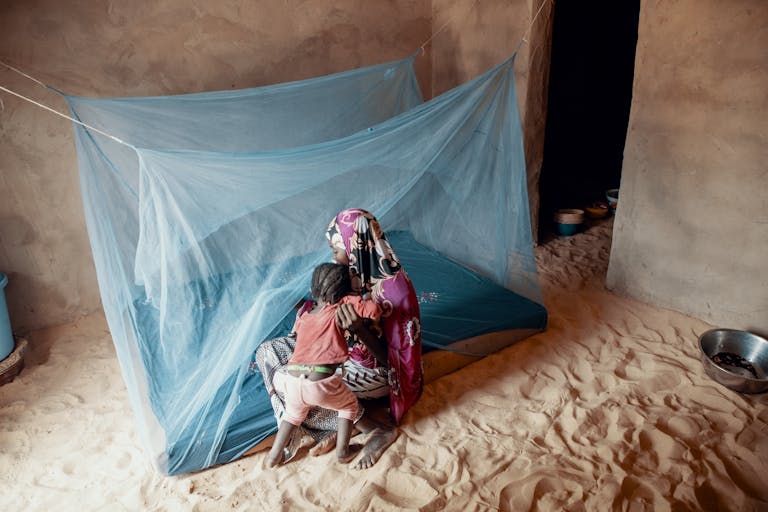Global health security is more than pandemic preparedness — it includes protection from the epidemics the world is already facing, like malaria, HIV/AIDS, and tuberculosis. COVID-19 has shown us that investing in malaria prevention, detection, and treatment can also lead to huge payoffs in pandemic preparedness. Strengthening health systems and investing in community care can help control — and potentially eliminate — malaria while bolstering our ability to detect and control the next major disease outbreak.
The connection Between COVID-19 and Malaria
For much of the world, efforts to combat COVID-19 and malaria are inseparable. The pandemic has posed a major threat to the delivery of malaria services because of supply chain disruptions, fewer people seeking care due to fear of getting COVID-19, overwhelmed health systems, and risks to the health and safety of front-line health workers.
Further complicating the problem, COVID-19 shares seven of 10 most common symptoms with malaria — including fever — making it difficult for patients and health workers to identify and properly treat these diseases. A health system that is already overwhelmed by malaria is ill-equipped to detect and deal with a surge of sick patients when a new outbreak emerges. Because of this, malaria hot spots are also blind spots for the next disease with pandemic potential, especially in communities whose basic health care is poor and whose disease surveillance is weak. As COVID-19 has shown us, an isolated outbreak can become a global pandemic in a matter of weeks.
However, for countries with weak surveillance systems, existing malaria programs can serve as the foundation for better and more widespread outbreak detection and rapid response. Malaria investments help scale up cost-effective ways to prevent and identify fevers, as well as the ability to diagnose, treat, and trace the source of infection to break transmission — all core components that a good malaria program and an effective pandemic response have in common.
In fact, health systems built through investments in malaria programs since 2000 have been repurposed to effectively deal with the COVID-19 pandemic. This includes training tens of thousands of health care workers to conduct early diagnosis and treatment of people with fevers, building and digitizing data systems to improve real-time surveillance of infectious diseases, improving availability of effective medicines and medical equipment, and building laboratory capacity in countries where malaria is occurring.

An integrated approach to Fighting Malaria and COVID-19
Recognizing that accelerated action on malaria relies on strong health systems and services, countries are taking an integrated approach to both the malaria fight and the COVID-19 response. For example, ensuring every fever is identified, reported, and treated is a fundamental building block for the malaria response and for early identification of pandemic threats. However, a flood of new hospital admissions combined with lockdowns and other tactics to limit the spread of disease restricts access to health facilities, which in turn increases the need for community-based care. Investment in community-based care for malaria and other fevers by community health workers allows treatment of many malaria cases at the local level, referring only severe malaria cases and fevers not caused by malaria to health centers.
This approach relieves significant pressure on overburdened health centers in malaria-endemic areas, where the disease can account for as much as 40% of admissions to health facilities. Community health workers treat 250 million suspected malaria cases annually — that’s 250 million patients that already strained health systems do not have to provide for, freeing up resources to handle new disease threats. The evidence is clear in how some low- and middle-income countries are responding to the pandemic. Vietnam, Rwanda, and Uganda — countries that previously built up front-line malaria capacity with support from the U.S. President’s Malaria Initiative and the Global Fund to Fight AIDS, Tuberculosis, and Malaria —were among the most successful in responding to COVID-19.
Guarding against current and Future Health threats
Expanded investment will be key to maximizing opportunities for the joint fight against COVID-19, malaria, and other health threats. Future pandemic preparedness and response can be bolstered through malaria investments in several promising areas.

First, investing in additional and better-equipped community health workers, especially in hard-to-reach areas, will make it easier to detect and treat malaria and other disease-related fevers at the community level. Critical investments in a robust health workforce will also support vaccine distribution, which is vital to ending this pandemic and closing gaps in other routine immunizations. What’s more, health systems with successful community engagement models — such as malaria action plans co-created with communities — can use these models as a foundation for enhanced community involvement during health emergencies, activating those systems to assist with outbreak response efforts when needed.
Strengthening surveillance systems for malaria can also bolster critical infrastructure for early detection and response to emerging pandemics. Investments in digitizing community health records, mobile technology, and mapping areas at risk of disease outbreaks can also support efforts to enhance rapid reporting and contact tracing.
Next, strengthening of procurement and supply chain systems will go a long way to protecting health programs from potential disruption by the next global pandemic. COVID-19 has showed the importance of resilient supply chains and local manufacturing of products that are essential to health services. Immediate investment is needed to ensure malaria programs can continue uninterrupted by securing adequate supplies of malaria commodities and addressing increased costs due to COVID-19 disruptions to global supply chains.
Lastly, strengthening and extending the reach of laboratory systems in countries with malaria cases — including investments in building human resources, infrastructure, and laboratory commodities — will be essential to expanding those countries’ capacity for rapid detection, diagnosis, and treatment of fever-causing illness, whether malaria or an emerging disease threat.
Coordinated and expanded malaria investments provide us with an opportunity to address the threat that weak health systems pose to not only to the populations they serve, but also to our entire, interconnected world. The past two decades of the malaria fight have created and strengthened health infrastructure, expertise, and country capacities that have been effectively leveraged to respond to the ongoing pandemic in many countries. We must seize this opportunity to build on those investments to create strong, resilient health systems that can realize the vision of a malaria-free future as well as prevent the next pandemic.
Feature Photo: Ollivier Girard/ UNICEF



 View All Blog Posts
View All Blog Posts


